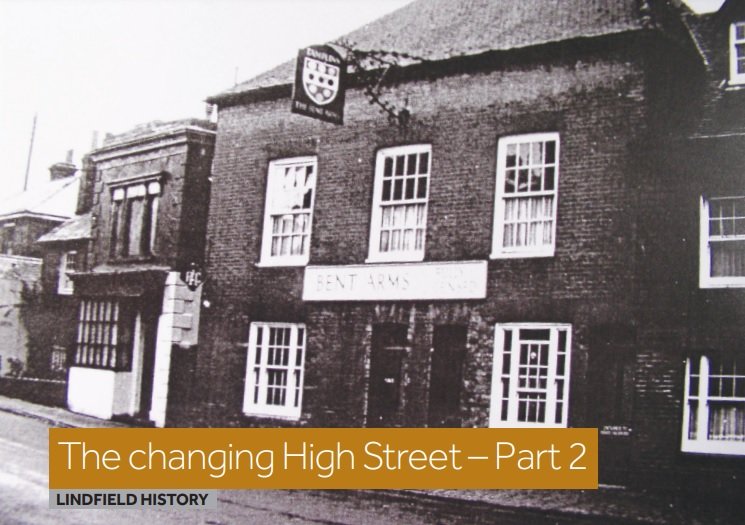We launched a Lindfield History book in June 2024! Life in Lindfield is written and compiled by Lindfield History Project Group and published by us (Kipper Life/Lindfield Life). You can buy copies of the book here, via our online store. Otherwise, please read on…
Articles published in:
2023
-
Lindfield History Project Group received a parcel containing hundreds of invoices dated between 1834 and 1835, for shopping and services supplied to the Tuppen household. Click here to learn about shopping in Lindfield’s history.
-
What is the connection between a car company, the theory of flight, an English university, the laws of combat, the concept of quality management and Walstead Burial Ground? The answer is Frederick William Lanchester. Click here to read more.
-
On Lindfield High Street in 1914, there were five public houses all selling beer obtained from commercial breweries, mostly in Brighton and Lewes. But one hundred years earlier, the village’s pubs were either brewing their own beer or being supplied by The Lindfield Brewery. Click here to read more.
-
The 3rd June 1953 was declared Coronation Day. To organise the celebrations in Lindfield, an Executive Committee with eight members was established. Click here to read all about the celebrations around Lindfield.
-
How much has the High Street changed in 100 years? This article compares the High Street in 1923 with today.
-
The previous article compared the west side of the High Street in 1923 with 2023; in this article we journey down the eastern side. Click here to read on.
-
Read here, all about the WWII submarine that disappeared without a trace and its connection to Lindfield.
2022
-
Click here to find out all about when, In 1899, the Lindfield Parish Council decided to form a volunteer fire brigade to provide fire cover for the parish.
-
To help the poor, between 1563 and 1601 the Government enacted legislation that provided a framework for the provision of poor relief by parishes. Click here to find out how Lindfield helped its poorer residents.
-
How has Lindfield celebrated royal events in the past? Click here to learn all about them.
-
Click here to read a continuation of the history of Lindfield’s royal celebrations.
-
In late 1921, an enterprising woman, Gladys Van Weede established - as sole proprietor - The Rainbow Pottery Company, trading from an outbuilding behind Abbotts Pharmacy on the High Street. Click here to read all about it.
-
From 1680 or earlier, three generations of the Neale family were innkeepers of the White Lion inn in Lindfield; later renamed the Bent Arms. Click here to read more.
-
Click here to find out all about Lindfield’s almost railway station.
-
If you or a family member have lived in Lindfield for many years, it would not be surprising if tucked away at the bottom of a drawer, or in an old album, there is a photograph by William Marchant. Click here to learn all about him.
2021
-
Ever wondered what Lindfield pond looked like in 1865? Click here to see and learn a little about the photo.
-
Click here to find out all about when the censuses started and what can they tell us about our village in years past.
-
Click here to find out all about the piano factory that was thriving in Victorian Lindfield.
-
This article looks at Lindfield fair through history.
-
Where have the Lindfield clergy resided in centuries past? Click here to find out.
-
Click here to find out all about Lindfield’s connection to Friar Tuck of Robin Hood fame and how John Bent gave his name to The Bent Arms.
-
This article explores another of Lindfield’s black history connections. The story begins with Francis Smith senior in Nevis, an island in the Eastern Caribbean. Click here to read more.
2020
-
The war had a dramatic effect on every aspect of life on the Home Front, to learn about Lindfield during this time, click here.
-
It is said that a village pub is the heart of the community. Click here to learn all about the pubs of Lindfield.
-
Here is part two of an in depth look at the pubs of Lindfield and their history.
-
Lindfield has often been described as possessing an ‘historic High Street’, due to the attractive and varied architectural styles of buildings lining the road, but what is the history of the road itself? Find out more here.
-
In the first days of May 1945, there was great expectation that the war would soon be over. Click here to find out more.
-
Although Lindfield School was established in 1881, its lineage can be traced back to William Allen in 1825. Click here to read all about it.
-
This article looks at Lindfield School between 1900 and 2000.
-
Residents have shared their memories with us from their time at Lindfield Primary School. Click here to read all about them.
-
The meeting place is stated as, ‘Society shall meet at the House of Thomas Finch, at the sign of the Tiger in Lindfield Town’. To learn all about the society and The Tiger click here.
2019
-
Did you know Lindfield had a castle? This was surrounded by a broad moat which joined to the river through gaps in the outer earthworks. Outside a ditch linked to a stream entirely surrounded the castle. Click here to read more.
-
In common with much of Lindfield, its origins can be traced back to Saxon times, when the lands are first mentioned in the copy charter dated 765. Learn more here.
-
All Saints Church at the top of the High Street was built in the 1300s in the Perpendicular style. Click here to learn all about it.
-
Lindfield was once little more than a high street with a few roads. Read here, the amazing transformation over the years.
-
A grand house with its origins in Elizabethan times, is perhaps an unlikely location for the founding of a revolution in education. Read Bedales history here.
-
During the first three quarters of the last century horticultural businesses thrived in and around Lindfield providing much employment. Read all about it here.
-
Until the early part of the 19th century, burial facilities were mainly provided by the Church of England in parish churchyards. Click here to find out why Walstead has its own burial ground.
-
It could be said that Lindfield is defined by the Common and Pond. To learn about their history, click here.
-
In 1938, Cuckfield Urban District Council, the local authority responsible for Lindfield, commenced planning for an evacuation. Click here to learn all about the children and the local families that took them in.
-
Does any other community have a bakery that traded continuously from the same premises for 223 years? Click here to learn all about the history of Lindfield’s oldest bakery.
-
Learn all about the history of Christmas traditions and how they’ve changed by clicking here.
2018
-
For eight hundred years much of the land in and around Lindfield formed the Manor of South Malling. Read more to find out how King Henry VIII changed all this.
-
Today nothing exists of the West Common and you would be forgiven for thinking the area completely lacks historical interest. However, there is always more to the story…
-
The land east of the High Street demonstrates the change and growth over 120 years which has helped to create today’s thriving community. Click here for more information.
-
Gravelye Lane for centuries was merely a track providing access to a couple of farmsteads and Northlands Wood. Find out what changed here.
-
At the top of the village, stands the grandiose and private Old Place that is largely obscured from view. Perhaps in a strange way, the property goes almost unnoticed when passing by. Learn here what it’s all about.
-
From the mid 1800s until about 60 years ago Lindfield was virtually encircled by big houses and their grounds. This article looks at two of these houses.
-
Mention ‘The Bent’ in Lindfield and one immediately thinks of The Bent Arms, but who was Bent and where did he live? Find out more here.
-
Lindfield’s The Old Forge is today, the home of Happy Feet Boutique children’s shoe shop, but how old is old? Click here to find out.
-
Lindfield Women’s Institute was established in June 1917. Activities included instruction in cooking, food economy, growing food crops, sewing and renovating old clothes. All that and more made these lovely ladies a beacon in struggling times. Read on to remember them.
-
News of the Armistice, bringing to an end the fighting, took time to spread and was not widely received until the following day. People needed to read it to believe it was true. Read here to see how locals celebrated.
-
Initial thoughts on a memorial for the village, as a permanent testament to the sacrifice made by local men, were first expressed in early 1919. Click here to learn more.
-
When did you last stand on Lindfield Bridge and look at the river? The dark, slow flowing water passes through private land with no public access, perhaps making it Lindfield’s hidden and forgotten river. Click here for more.
2017
-
Long before our smooth roads, horses had the hard job of pulling heavy carriages over all sorts of surfaces. Julius Guy, a Lindfield carriage builder, set about finding a way to improve the suspension and so much more. Read about this local hero today.
-
Worcester Sauce became popular in the 1840/50s and is still widely used. Today, instead of asking for Worcester sauce, you could have been asking for Lindfield Sauce had its makers had the business acumen of Mr Lea and Mr Perrin. Click here for more.
-
In the Mid Sussex Times in 1913 was: ‘As the result of a public reading at the Haywards Heath Corn Exchange, Dickens was able to hand £100 to the then Vicar of Lindfield ‘. But who wrote to the Times and why was Dickens handing over so much cash? Click here to find out.
-
Lindfield parish church had been in a poor state of repair for years. The problems stemmed from the church receiving very little money. Find out how Reverend Francis Hill Sewell saved the church.
-
A newspaper report in August 1861 commented that the school was ‘among the finest educational structures in Sussex.’ To find out more click here.
-
There were very few days during The Great War that determined how future land battles across the world would be fought; a son of Lindfield played a leading role in one such day. Please read on to find out more about our local hero.
-
Mention The Welkin to Lindfield residents today and it conjures up images of the houses with their neat gardens and well maintained grounds in the area behind the High Street and north of Hickmans Lane. Find out more here.
-
The name Finches does not derive from a Victorian country mansion. It is much older in origin dating back to a farm that existed in medieval times, with perhaps the land being farmed a thousand years ago. Click here for more.
-
This article explores the early history of the area and how Lindfield as we know it today came about. The first recorded reference to Lindfield is in a Saxon charter dated 765! Click here for more.



































